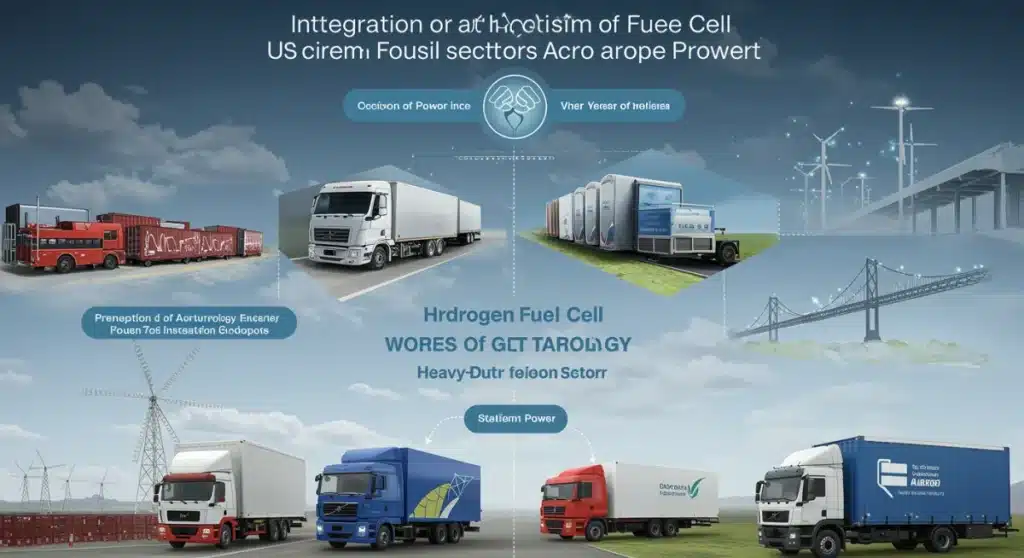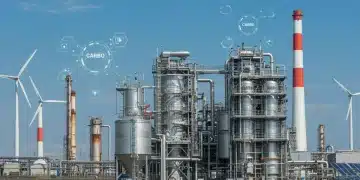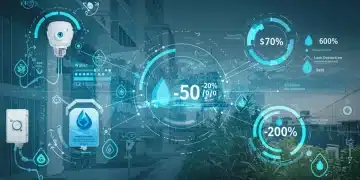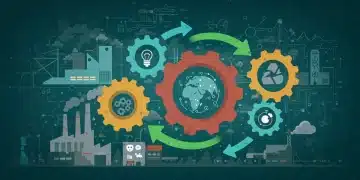Hydrogen Fuel Cells: 2025 US Commercial Outlook & Recent Updates

The 2025 outlook for hydrogen fuel cells in US commercial applications reveals accelerated adoption driven by policy support and technological advancements, positioning them as a critical component of the nation’s sustainable energy future.
The landscape for hydrogen fuel cells in US commercial applications is rapidly evolving, with significant recent updates shaping a compelling 2025 outlook. As industries seek sustainable energy solutions, hydrogen fuel cell technology is emerging as a powerful contender, offering unique advantages for various sectors. This analysis will delve into the current state, recent advancements, and future projections for this critical clean energy pathway.
Current State of Hydrogen Fuel Cell Adoption in the US
As of late 2024, the adoption of hydrogen fuel cells in the US commercial sector is experiencing notable growth, particularly in niche markets and pilot programs. Heavy-duty transportation, material handling, and stationary power generation are leading the charge, demonstrating the technology’s viability and operational benefits. Early adopters are reporting reduced emissions, improved operational efficiency, and a significant step towards decarbonization goals.
Government incentives and private investments are fueling this expansion. The Department of Energy (DOE) and various state initiatives are providing crucial support for infrastructure development and research, accelerating the transition from demonstration projects to wider commercial deployment. This strategic push is laying the groundwork for a more robust hydrogen economy by 2025.
Key Commercial Sectors Embracing Hydrogen
- Material Handling: Forklifts and warehouse equipment are widely utilizing hydrogen fuel cells for their rapid refueling times and consistent power output, outperforming traditional battery electric options in high-throughput operations.
- Heavy-Duty Transportation: Class 8 trucks and public transit buses are increasingly being piloted and deployed, showcasing hydrogen’s potential for long-haul routes and demanding schedules without the range anxiety associated with battery electric alternatives.
- Stationary Power: Fuel cells are providing reliable, uninterruptible power for data centers, critical infrastructure, and remote locations, offering a clean alternative to diesel generators.
- Port Operations: Equipment like yard tractors and cranes are being converted to run on hydrogen, aiming to significantly reduce emissions in busy port environments.
Recent Technological Advancements and Efficiency Gains
Breakthroughs in fuel cell technology are continually enhancing their performance, durability, and cost-effectiveness. Researchers and manufacturers are focused on improving catalyst materials, membrane durability, and overall system integration, which are critical for broader commercial viability. These advancements are directly impacting the 2025 outlook for hydrogen fuel cells in US commercial applications, making them more competitive.
New designs are leading to more compact and powerful fuel cell stacks, allowing for easier integration into diverse vehicle platforms and power systems. Furthermore, improvements in hydrogen storage solutions, including higher-density tanks and novel solid-state storage materials, are addressing previous limitations related to onboard fuel capacity and safety. These innovations are crucial for expanding the operational envelopes of hydrogen-powered assets.
Innovations Driving Performance Improvements
- Catalyst Development: Reduced platinum group metal (PGM) loading and the development of non-PGM catalysts are lowering manufacturing costs and increasing sustainability.
- Membrane Technology: Enhanced proton exchange membranes (PEMs) are improving efficiency and extending operational lifespans, especially under varying environmental conditions.
- Balance of Plant Optimization: Components like compressors, humidifiers, and control systems are becoming more efficient and integrated, reducing parasitic losses and overall system complexity.
Policy and Regulatory Landscape Shaping 2025 Outlook
The US government’s commitment to decarbonization is a significant driver for the adoption of hydrogen fuel cells in US commercial applications. Federal and state policies, including tax credits, grants, and regulatory frameworks, are creating a favorable environment for investment and deployment. The Infrastructure Investment and Jobs Act (IIJA) and the Inflation Reduction Act (IRA) have allocated substantial funding for hydrogen hubs and clean hydrogen production, directly impacting the supply chain and cost structure.
States like California are at the forefront, implementing stringent emissions standards and offering incentives for zero-emission vehicles, which naturally includes hydrogen fuel cell electric vehicles (FCEVs). These policies are not only stimulating demand but also encouraging private sector innovation and manufacturing within the US. The regulatory landscape is evolving to ensure safety, standardization, and interoperability across the nascent hydrogen ecosystem.
As of late 2024, several states are actively developing their own hydrogen strategies, often aligning with federal goals while tailoring approaches to regional resources and industrial needs. This decentralized yet coordinated effort is crucial for building a resilient and diverse hydrogen supply chain across the nation. The aim is to create a robust market that supports broad commercial application by 2025 and beyond.
Key Policy Drivers and Initiatives
- Hydrogen Hubs: Federal funding for regional clean hydrogen hubs aims to establish production, processing, delivery, storage, and end-use infrastructure, creating localized ecosystems.
- Production Tax Credits: The IRA’s clean hydrogen production tax credit (45V) significantly reduces the cost of green hydrogen, making it more competitive with fossil fuels.
- Zero-Emission Vehicle Mandates: State-level mandates are accelerating the transition of commercial fleets to zero-emission technologies, including FCEVs.
- Research and Development Funding: Continued government investment in R&D supports technological breakthroughs and addresses remaining technical barriers.
Comparison with Other Clean Energy Alternatives
When analyzing the 2025 outlook for hydrogen fuel cells in US commercial applications, it’s essential to compare them with other clean energy alternatives, primarily battery electric vehicles (BEVs) and advanced biofuels. Each technology presents distinct advantages and limitations, making the choice dependent on specific operational requirements and use cases. Hydrogen fuel cells excel in applications demanding long range, heavy loads, and rapid refueling, where battery weight and charging times can be prohibitive.
For instance, in long-haul trucking or high-utilization material handling, the quick refueling of hydrogen tanks (minutes) offers a significant operational advantage over the extended charging times (hours) required for large battery packs. While BEVs are highly efficient for shorter distances and lighter loads, hydrogen’s energy density allows for greater range and payload capacity, crucial for heavy-duty commercial operations. Biofuels, while offering a drop-in solution for existing infrastructure, often face scalability and sustainability challenges.
The optimal clean energy strategy for many commercial entities will likely involve a combination of these technologies, leveraging the strengths of each. Hydrogen fuel cells are positioned to fill critical gaps where electrification alone may not be sufficient, particularly in sectors that are hard to decarbonize. This complementary role underscores their importance in a diversified clean energy portfolio.
Key Comparative Advantages of Hydrogen Fuel Cells
- Rapid Refueling: Minutes versus hours for battery electric vehicles, minimizing downtime for commercial fleets.
- Extended Range: Higher energy density allows for longer operational distances, critical for heavy-duty transport.
- Consistent Performance: Power output is maintained regardless of charge level, unlike some battery systems.
- Payload Capacity: Lighter than comparable battery systems, allowing for greater cargo capacity in heavy vehicles.
Infrastructure Development and Supply Chain Challenges
The successful scaling of hydrogen fuel cells in US commercial applications by 2025 hinges significantly on the pace of infrastructure development. A robust network of hydrogen production, distribution, and refueling stations is paramount for widespread adoption. While significant investments are underway, particularly through the federal hydrogen hub initiatives, building out this infrastructure across diverse geographies remains a complex undertaking.
Key challenges include the high capital cost of building new hydrogen production facilities, the need for efficient and safe distribution methods (pipelines, cryogenic tankers), and the strategic placement of refueling stations to serve commercial routes. As of late 2024, the number of publicly accessible hydrogen refueling stations is limited, primarily concentrated in California. Expanding this network nationally is a critical step for unlocking the full commercial potential of hydrogen fuel cells.
Furthermore, establishing a reliable and cost-effective supply chain for green hydrogen production is crucial. This involves scaling up renewable energy sources for electrolysis, developing advanced electrolyzer technologies, and ensuring the availability of skilled labor. Addressing these infrastructure and supply chain hurdles is central to realizing the 2025 vision for hydrogen fuel cells.
Overcoming Infrastructure Hurdles
- Strategic Hub Development: Concentrating initial infrastructure in key industrial and transportation corridors to create early demand.
- Public-Private Partnerships: Collaborating between government and private entities to share investment risks and accelerate deployment.
- Standardization: Developing common standards for refueling connectors, pressure levels, and safety protocols to ensure interoperability.
- Scalable Production: Investing in large-scale green hydrogen production facilities to drive down costs and ensure consistent supply.
Economic Implications and Investment Outlook for 2025
The economic implications of expanding hydrogen fuel cells in US commercial applications are substantial, projecting significant job creation, new market opportunities, and a reduction in reliance on fossil fuels. The investment outlook for 2025 remains highly positive, driven by sustained government support, increasing corporate sustainability commitments, and advancements in technology that enhance economic viability. Private capital is increasingly flowing into hydrogen startups and established companies developing fuel cell technologies and infrastructure.
Cost reduction is a critical factor for wider market penetration. As production scales and technological efficiencies improve, the total cost of ownership for hydrogen FCEVs and stationary power systems is expected to become more competitive with traditional and other clean energy alternatives. This includes not only the upfront capital costs but also operational expenses related to fuel and maintenance. Analysts project a continued downward trend in hydrogen production costs, especially for green hydrogen, making it an even more attractive proposition.
The development of a robust hydrogen economy will also spur innovation across various sectors, from advanced materials to digital controls for energy management. This creates a ripple effect of economic growth and technological advancement. Investors are keenly watching policy developments and early commercial successes as indicators for future market expansion.
Key Economic Drivers
- Job Creation: Growth in manufacturing, engineering, construction, and operations roles across the hydrogen value chain.
- Reduced Operating Costs: Declining hydrogen fuel prices and improved fuel cell durability lead to lower long-term operational expenses.
- Energy Security: Diversifying energy sources reduces dependence on volatile global fossil fuel markets.
- Export Opportunities: The US can become a leader in hydrogen technology and production, creating export markets for equipment and expertise.
| Key Aspect | Brief Description |
|---|---|
| Market Adoption | Accelerating in heavy-duty transport, material handling, and stationary power due to operational benefits. |
| Technological Progress | Improvements in efficiency, durability, and cost-effectiveness are making fuel cells more competitive. |
| Policy Support | Federal and state incentives, like tax credits and hydrogen hubs, are driving significant investment and growth. |
| Infrastructure Needs | Expansion of hydrogen production, distribution, and refueling networks is crucial for widespread adoption. |
Frequently Asked Questions About Hydrogen Fuel Cells
In the US, hydrogen fuel cells are primarily utilized in material handling (forklifts), heavy-duty transportation (trucks, buses), and stationary power generation. They offer advantages like rapid refueling and extended range, making them ideal for high-utilization commercial operations seeking to decarbonize.
Recent policy changes, such as the Infrastructure Investment and Jobs Act and the Inflation Reduction Act, significantly boost hydrogen fuel cell adoption. These acts provide substantial funding for hydrogen hubs, production tax credits, and R&D, lowering costs and accelerating infrastructure development across the US.
Technological advancements include improved catalyst materials, more durable membranes, and optimized balance-of-plant components. These innovations lead to increased efficiency, longer operational lifespans, and reduced manufacturing costs, enhancing the overall commercial viability and competitiveness of fuel cell systems.
Hydrogen fuel cells generally offer quicker refueling times and greater range for heavy-duty commercial applications compared to battery electric vehicles. While BEVs suit shorter routes and lighter loads, fuel cells are often preferred for long-haul transport and continuous operations where minimizing downtime is critical.
The main challenges for widespread hydrogen infrastructure by 2025 include the high capital costs of production facilities, the need for efficient distribution networks, and establishing a sufficient number of refueling stations. Scaling green hydrogen production and ensuring supply chain reliability are also critical hurdles.
Looking Ahead
The 2025 outlook for hydrogen fuel cells in US commercial applications signals a period of accelerated growth and strategic deployment. With robust policy support, continuous technological advancements, and increasing industry commitment to decarbonization, hydrogen is poised to play an indispensable role in the nation’s clean energy transition. Stakeholders should monitor the progress of hydrogen hub development, the expansion of refueling infrastructure, and the evolving economic competitiveness of green hydrogen as key indicators of this transformative shift. The momentum suggests a future where hydrogen fuel cells power a significant portion of US commercial operations, driving both environmental sustainability and economic innovation.





